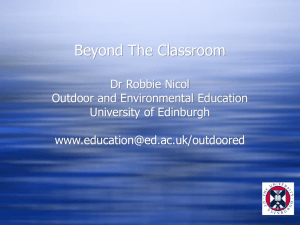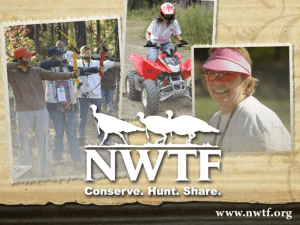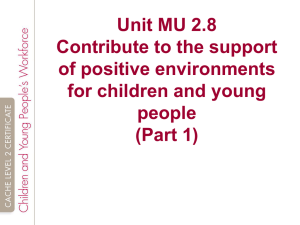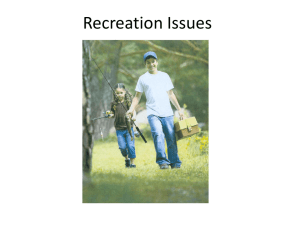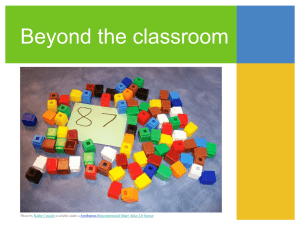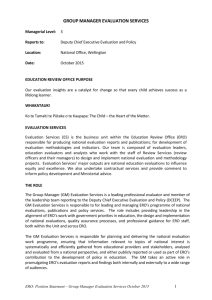Letting Go: child-led learning in the outdoor environment
advertisement
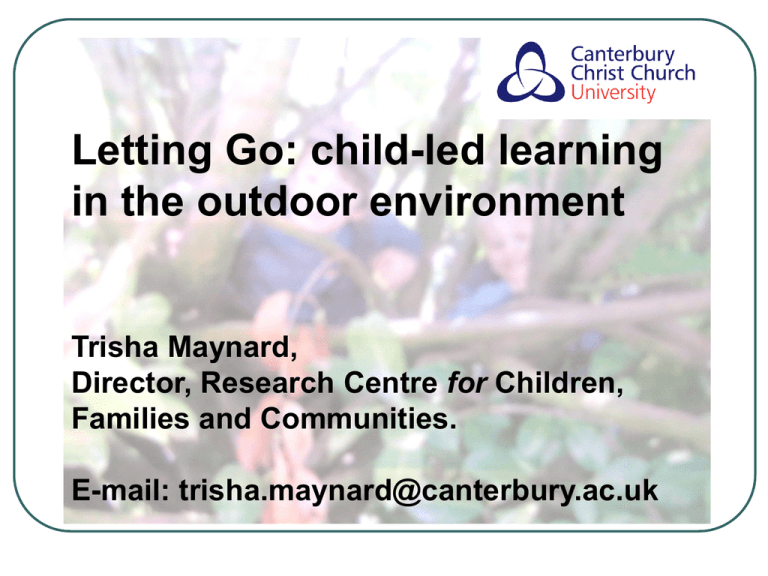
Letting Go: child-led learning in the outdoor environment Trisha Maynard, Director, Research Centre for Children, Families and Communities. E-mail: trisha.maynard@canterbury.ac.uk Introduction...Context Foundation Phase for Wales Child-initiated learning in the outdoor environment Interest in Reggio Emilia – child-led learning Focus and structure of this presentation… The perceived risks of child-led learning outdoors A story in three parts: 1. What the practitioners said about childled learning outdoors 2. The projects 3. Their use of the outdoor environment and the perceived ‘risks’ of child-led learning outdoors Interpretations… ‘Child-initiated’ – the same as ‘childled’? Play/being playful and learning ‘Child-initiated’ - encompasses play/playful and active learning approaches that are essentially led by the child. Risk – what is this? (e.g.Tovey, 2007) Why child-led learning outdoors? Child-led learning may be easier outside… and more appropriate: • it appeared easier for teachers to relinquish control and allow children to take the lead in their learning when outside the classroom walls (see Maynard 2007); • child-initiated learning is likely to be supported by being in the diverse, rich, sensory outdoor environment. Swansea Projects 1 ‘Forest School – an evaluation’ (Trisha Maynard et al.) 2 ‘Outdoor Play and Learning’ (Trisha Maynard and Jane Waters) (OP&L) 3 ‘Through a Different Lens: Exploring Reggio Emilia in a Welsh Context’ (Trisha Maynard and Sarah Chicken) (Reggio) 4 ‘Exploring Reggio Outside’ (ERO) 5 ‘The ‘underachieving’ child: exploring the impact of the outdoor environment on children’s learning, behaviour and wellbeing’ (TUC) 6 ‘Exploring practitioners’ perspectives of well-being in early years settings’ (EWB) (Trisha Maynard, Jane Waters and Jennifer Clement) Methodologies/methodsReggio projects Loosely-based on action research model; Socio-cultural approach- research ‘team’; Series of seminars – interpretations and co-construction of key ideas; Exploration of child-led learning within settings. Data / data analysis Data: interviews, observations (videorecorded), field notes, documentary evidence. Thematic analysis of the teacher interviews and written reports + field notes and documentary evidence; Codes used to identify themes; use of Nvivo 8; Analysis of the video observations (in ERO) using own framework. Part One… What did the teachers say about child-led learning outdoors… … and what use did they make of their outdoor environments? Teachers’ enjoyment of the outdoor environment… I love it. I just wish I could get out there more. I really enjoy being out it’s lovely. The children, the fresh air and just the feeling of being out. I’ve always loved being out from a little child. When I grew up I was always out. I had the opportunity to go climbing mountains and things like that. My walk to school was always through big ferns and it was all the smells. I love it and it’s quite sad that these children don’t get these opportunities now. I just wish we could do more. ERO School B Int 3 Children’s enjoyment of the outdoor environment… …they absolutely love it...The looks on their faces, their voices change, their body language is different, they’re off running, excited, the whole energy is different, isn’t it. It’s just fantastic. ERO School D Int. 3 The outdoor environment… I mean it’s all going on out there isn’t it. The weather, the…It’s all you know real life is out there. It’s not made and put on a board, a pretty picture by me. It’s out there it’s happening. You know, the planes in the sky and the clouds and the weather and the wildlife. It’s all there isn’t it the whole curriculum is there. ERO School D Int.3 The space for one thing. The children are not confined to a small area they have far more space there. I think once they have got over that initial excitement of having the freedom then they do focus in upon whatever they are doing. As I’ve said you’ve got all the natural materials outside that you can work with. You’ve got all the physical activities that you can do. ERO School F FP. The health benefits obviously, it’s fresh air, it’s not nasty central heating with all the germs flying around as there are at the moment... ERO School D, Int 3 Benefits for practitioners… …I’ve definitely got now, more of an insight into how children are thinking, what they’re thinking about. I’ve listened to their ideas and seen how they can make connections and the language that they’ve been using freely and I feel I know them better than I did before. ERO School D Int.3 Child-led learning outdoors… perceived benefits Enthusiasm/ motivation/ curiosity... [The children] are running with their own ideas on things, the motivation is there to explore. It’s just… the looks on their faces. It tells me, you know, there is no other evidence you need really. ERO School D Int. 3 Imagination… I was really pleased with the range of ideas they have come up with. And how excited they’ve been to come up with those ideas. They’re just so kind of on it, you know, you can almost see their brains working.... Children have got some great ideas and they just bounce off each other. ERO School D Int.2 Co-operation… The team spirit demonstrated by 4 and 5 year olds would put some adults to shame. They worked in harmony, taking turns, sharing, cooperating and discussing together. ERO School G FP …when they are working outside…they just get on with it. They get on with everybody. There’s no quarrelling. They never say – ‘Oh what can I do now?’ ‘What can I do next?’ They never ask to come in if I’m honest. ERO School E Int. 3 Engagement… …it’s because they’ve got more of a leading role in the project. It’s… they are the ones who came up with it. They are the ones who are going back and forth to it all the time perhaps that why they’re very … they value it a bit more I suppose. It’s their sort of ideas and their work . ERO School A Int.2 Benefits for particular groups of children… Some of the quieter ones have become a lot more outgoing. I’ve also noticed when they are actually on task with something they are really enjoying it because it’s their interest. ERO School A Int. 3 Children who were very shy and lacking in confidence changed outdoors and became totally different children. They became leaders and instigators. They followed their ideas and were willing to work with others. ERO School B FP I’ve got one child in the class who is very quiet and has great difficulty in any formal work and he’s very reluctant to speak, but outside, doing any activities like that, building, creating, whatever, he… his speech is developing and he’s quite…yes… he’s quite happy to discuss what he’s been doing. ERO School F Int.2 …probably those children with a little bit more of a behaviour problem are the ones that benefit most. ERO School E Int.1 The livelier children are far more motivated outdoors with hands on activities, and are so engrossed they seem to get less distracted so less problems occur…. …Some less able children who don’t enjoy sitting at the table, thoroughly enjoy working outside because there’s no failing outside and no right and wrong. ERO School G Int 3 Part Two A closer look at child-led learning… …examples from the ERO project. Part Three The practitioners’ use of the outdoor environment …and the perceived risks of child-led learning outdoors The Practitioners’ Use of the Outdoor Environment Not all the practitioners made use of their outdoor environments. For example in the ERO project: Three of the eight teachers took the children outside every day ; One teacher - a couple of times a week; One teacher - a couple of times a month; Three teachers - less than a couple of times a month. This pattern was replicated in other projects. More than ‘constraints’? Practical ‘constraints’: access, staff, vandalism, weather, clothing, Christmas…. ERO – these were not always correlated with the teachers’ use of the outdoor environment. Not fully aware of potential uses and benefits of the outdoor environment. Cultural reluctance? Pervasiveness of an instrumental view of the curriculum. Six perceived (and inter-related) ‘risks’ of child-led learning outdoors There is a risk that…. 1 The headteacher, parents, governors, inspectors will not understand/approve of what I’m doing and complain; 2 The children may get hurt; There is a risk that… 3 I may not achieve what I’m meant to achieve (child-led learning takes too long!): a) Getting outside b) ‘Listening’ to children… c) It’s easier to tell them! d) Children won’t learn what they’re meant to be learning i.e. content 4 I may lose my authority/ identity (sense of self) as a teacher; 5 I may lose control (of ‘bodies and minds’); 6 I may end up looking stupid (I don’t know what to do or how to support the children!). Common questions… • What do I do/ where do I position myself when • • • • • the children are involved in play/active learning experiences? At what point should I intervene? What level and kind of support is appropriate? What kinds of questions are appropriate? What is the difference between (positive) intervention and (negative) interference? And when do I tell them the ‘right’ answer? Conclusion Is child-led learning outdoors worth the risk? Do the benefits outweigh the potentially undesirable consequences? There may be criticisms/complaints; The children may fall and hurt themselves; The children may not learn what teachers think they should learn; The children may be more challenging, less conforming – demonstrate their agency It may require teachers to reconstruct their perceptions of a good teacher and a good pupil and of how knowledge is (co-) constructed; It may require teachers to develop new knowledge and skills… These may include… Reconstructing; ‘Listening’; Letting go; Refocusing; Framing; Restraining; Searching (see Maynard and Chicken, 2010) And the benefits? If given the space and time, many (though not all) children will demonstrate their enthusiasm, motivation, confidence, concentration, curiosity, creativity, commitment, co-operation, focus…... Isn’t this a risk worth taking? References – own published articles/chapters Maynard, T. and Chicken, S. (2010) Through a Different Lens: Exploring Reggio Emilia in a Welsh Context, Early Years. Maynard, T. (2007) ‘A Risky Business? Encounters with Forest School and Foucault’, Education 3-13, 379-391 Maynard, T. and Waters, J. (2007) ‘Learning in the Outdoor Environment: a missed opportunity’, Early Years: An International Journal of Research and Development, 27(3): 255-265. Maynard, T. (2007) ‘Forest Schools in Great Britain, an initial exploration’, Contemporary Issues in Early Childhood, Vol 8 (4): 320-331. Maynard, T. (2007) ‘Making the Best of What You’ve Got: Adopting and Adapting the Forest School Approach’ in Austin, R. Letting the Outside In, Stokeon-Trent: Trentham Books. Unpublished Reports Maynard, T., Waters, J., and Clement, J. (2008) Exploring Reggio Outside: children playing and learning in the outdoor environment, Swansea University. Maynard, T. and Chicken, S. (2006) Through a Different Lens: Exploring Reggio Emilia in a Welsh Context, Swansea University. New publications on play from TACTYC members include: Broadhead, P., Howard, J. and Wood, E. (2010) Play and Learning in the Early Years, London: Sage. Brooker,L. and Edwards, S. (2010) Engaging Play, Maidenhead: OUP (McGraw Hill). Moyles, J. (Ed) (2010) Thinking about Play: developing a reflective approach, Maidenhead: McGraw-Hill. Moyles, J. (Ed.) (2010) The Excellence of Play (3rd Edition), Maidenhead: McGraw-Hill. Useful resources for outdoor play and learning in the early years include: Bilton, H. (2010) (3rd Edition) Outdoor Learning in the Early Years: Management and Innovation, London: Routledge. Garrick, R. (2009) (2nd Edition) Playing Outdoors in the Early Years, London: Continuum. Knight, S. (2009) Forest Schools and Outdoor Learning in the Early Years, London: Sage. Tovey, H. (2007) Playing Outdoors: Places and Spaces, Risk and Challenge, London: OUP. White, J. (2007) Playing and Learning Outdoors, London: Routledge.
